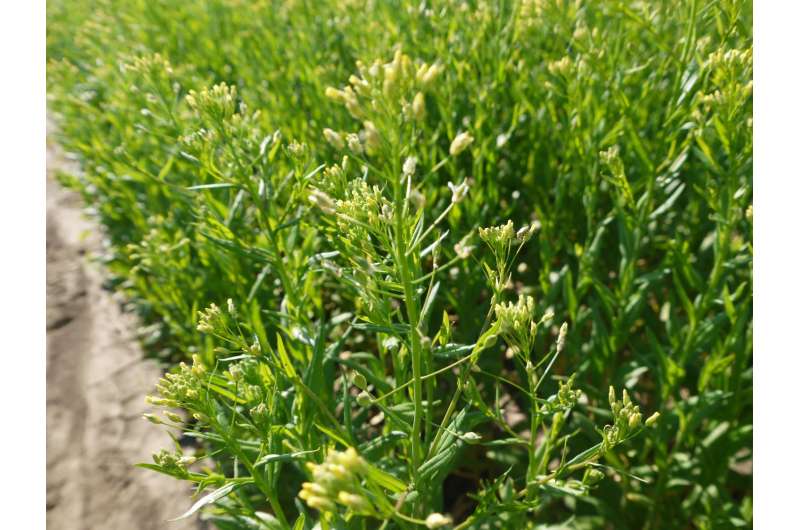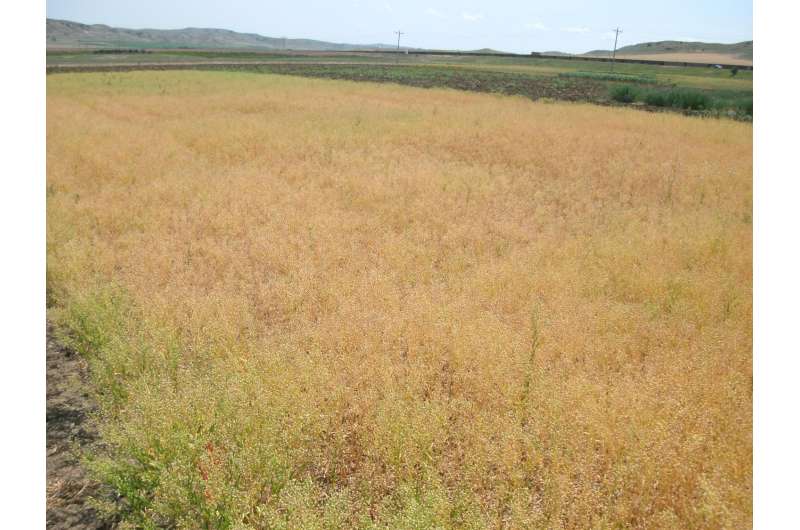Where you grow what you grow: Camelina's varied response to location

Camelina: Have you heard of it? It's an emerging alternative oilseed crop in parts of the Great Plains.
A new study, led by Augustine Obour at Kansas State University, looks at how three varieties of camelina perform when grown in two different regions within the Great Plains.
The end goal is to find the camelina variety that performs best in each location or environment.
"It's actually a challenge to identify alternative crops that are well adapted to semi-arid areas of the Great Plains," says Obour. "Plus, these crops have to fit into existing crop rotations."
That's where camelina excels. It's a short-season, cold-tolerant crop that grows well on marginal lands. It is also compatible with existing farm equipment used for grain crops.
Oil extracted from camelina seeds has several uses. It can be used for biodiesel and renewable jet fuel production. It is also a good source of α-linolenic acid, a precursor for other healthy fatty acids essential for human and animal health. Together with camelina meal, the oil can also be used to manufacture adhesives, coatings, gums, resins, and varnishes.
Most of the research on camelina cultivation has focused on the northern parts of the Great Plains - parts of Montana and Wyoming. But the Great Plains stretches over 500 miles east to west, and 2000 miles north to south. Environmental conditions can vary widely in different parts of the Plains.
"Conditions, such as rainfall and air temperature, can have significant effects on yield and oil content of camelina," says Obour. For example, heat and moisture stress during flowering can reduce seed yield and alter oil composition.
How would camelina perform when grown in the central Great Plains - western Nebraska and Kansas?

To answer this question, the researchers picked two test sites. One of the test sites was in Hays, Kansas, in the central Great Plains. Hays has relatively early springs and warmer summer air temperatures. The other test site was in Moccasin, Montana, in the northern Great Plains, with relatively cooler spring and summer temperatures. Moccasin also has lower average annual rainfall than that of Hays.
"These two sites provided us with an opportunity to test the effects of environmental conditions on camelina growth, yield, and oil composition," says Obour.
But environmental conditions aren't alone in affecting how crops perform. Differences in the genetic makeup of crop varieties also influence which ones thrive in specific environments. "Different varieties of camelina respond to environmental stresses differently," says Obour. "That ultimately affects yield and oil content."
Over the course of three years, Obour and his colleagues grew three different camelina varieties in the two test sites. This way, the researchers could test how camelina genetics and environmental conditions together affected yield and oil content.
All three camelina varieties performed similarly at Moccasin, despite their genetic differences. At Hays, however, one variety, called Blaine Creek, had 42% higher seed yields than the other two. "This highlights the importance of looking at both crop genetics and environmental conditions," says Obour.
Overall, camelina seed yields were 54% lower at Hays than at Moccasin. The researchers also found that camelina oil content was lower at Hays. However, seed protein content was significantly higher at Hays.
Oil composition was different between the two test sites as well. Monounsaturated and saturated fatty acid contents were greater at Hays but polyunsaturated oil content was lower. This is important for growers to know so they can better target their crop to a chosen market.
"Our findings confirm that camelina seed yield, oil content, and fatty acid composition are significantly affected by both the environment and camelina genetics," says Obour.
Obour's work continues. "The next line of research is selecting camelina varieties that are tolerant to heat stress," says Obour. That will allow for improved seed yield, oil content, and fatty acid profile of camelina grown across the central Great Plains.
More information: Augustine K. Obour et al, Camelina Seed Yield and Fatty Acids as Influenced by Genotype and Environment, Agronomy Journal (2017). DOI: 10.2134/agronj2016.05.0256
Journal information: Agronomy Journal
Provided by American Society of Agronomy



















